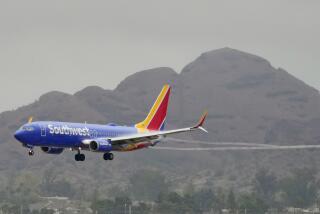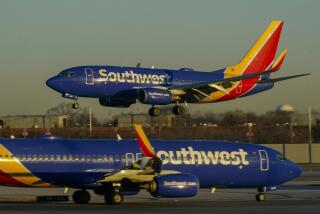American Airlines Unveils Radical Plan to Cut Fares : Travel: Long-term effort to raise revenues favors last-minute, business fliers. Other carriers follow suit.
Triggering a major overhaul of the nation’s air fares, American Airlines on Thursday unveiled a new fare schedule that dramatically cuts the price of flying for passengers who make last-minute plans.
American’s move was quickly matched by other U.S. carriers, although it is a risky, long-term effort to raise revenues and stimulate passenger traffic, both of which have suffered as a result of the recession and last year’s Gulf War.
The lower fares are aimed primarily at appeasing and attracting business travelers, who have curtailed travel plans during the recession and complained about the large price gap between passengers who fly on short notice--mostly business people--and leisure travelers who can take advantage of advanced purchase discounts.
Many business people cannot qualify for the deep discounts--sometimes nearly 80% off the regular coach fare--because of rules that require a Saturday night stayover as well as the purchase of tickets from one to three weeks in advance.
“We are particularly optimistic about more travel by those who work for small businesses, who have cut back very heavily on travel,” said American Chairman Robert L. Crandall, in announcing the new pricing schedule.
However, if the new price structure fails to quickly increase traffic, the industry, which has seen historic losses during the economic downturn, risks sinking much deeper into the red and contributing to the demise of the weakest carriers.
Under American’s plan, the price of unrestricted coach fares will fall by at least 38% and that of first-class seats by 20% to 50%. However, American will also eliminate deep discounts for corporate clients, governments agencies and groups attending meetings and conventions.
The airlines will continue to offer restricted discounts of up to 49% on tickets purchased seven or 14 days in advance and require passengers to stay over a Saturday night. The tickets are still non-refundable, but the airlines will now allow passengers to use them on an alternative trip for an additional $25 fee.
The carriers hope more people will buy the lower regular fares rather than taking the trouble to qualify for the deeper discounts. They also hope to generate more business in general and cut the cost of administering and processing the thousands of different fares now available.
The new fares went into effect Thursday for travel beginning April 13. So far, Alaska Airlines, America West, Continental, Delta, Northwest, United and USAir have adopted the new fare schedules.
Under the new structure, the price of a round-trip, unrestricted coach ticket between Los Angeles and New York would fall to $920 from $1,504. The cost of a round-trip fare purchased 21 days in advance would drop to $460 from $549.
In the long run, American said the new fare plan could boost income by $300 million to $350 million a year. But in the short run, the new pricing system will probably cost American about $100 million in the second quarter.
Travel agents, who earn a commission based on the price of the tickets they sell, also stand to see their income fall in the next few months. However, most were supportive of the new fare schedule, which that dramatically reduces the hundreds of thousands of fares that are currently available.
“It’s a very aggressive program that will be very well received by our customers,” said Tom Nulty, president of Santa Ana-based Associated Travel Management. “Its simplicity is its best feature. Our agents will be able to handle more transactions.”
The lower fares might coax extra trips from business travelers whose corporate travel budgets have been frozen or reduced, said Jay Anderson, vice president at the Orange office of USTravel.
“They might be able to get more travel out of the same budget,” Anderson said. “But not a lot is going to happen. I don’t think we are going to see the effects for 90 days or more.”
The recession and corporate restructuring also may dilute the impact of the lower fares.
Nancy Godfrey, travel manager at San Francisco-based Chevron Corp., said the fare cuts will not prompt many extra trips from the energy company.
“We are going through some restructuring right now . . . and people are concentrating on something else instead of travel. In the end, it will be good news, but I don’t think that will change (travel spending) for us right now.”
The new fare structure could actually increase the cost of air travel for some, said industry observers, and the savings from the new fare structure will not be as great for travelers who took advantage of the deepest discounts. In fact, 95% of all airline tickets are sold at a discount, and the airlines over the past few months have made those discounts less lucrative and harder to obtain for leisure travelers.
“What they are trying to do is cater to the top end of the market,” said Barbara L. Beyer, president of Avmark, a Washington, D.C.-based aviation consulting firm.
The many companies that managed their travel costs carefully and took advantage of corporate and volume discounts might end up paying more under the new prices, said John Hintz, president of the National Business Travel Assn., a group of business travelers and travel agents.
“The best managed companies might end up paying more,” Hintz said.
The lower fares also might drive some weaker airlines out of business, say some industry observers. The lower fares would reduce the price advantage now held by America West, Continental and Trans World Airlines, which are all operating under the protection of bankruptcy court.
More to Read
Inside the business of entertainment
The Wide Shot brings you news, analysis and insights on everything from streaming wars to production — and what it all means for the future.
You may occasionally receive promotional content from the Los Angeles Times.










